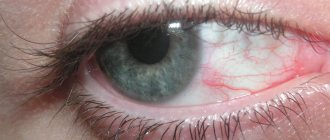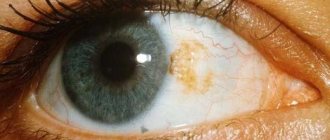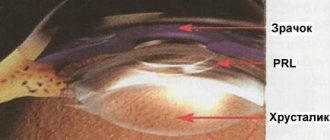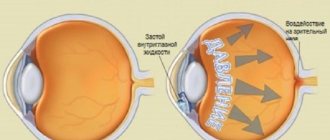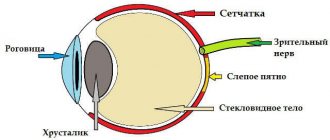Main symptoms:
- Pain in the eyes
- Pain when moving the eyeball
- Eye fatigue
- Inflammation of the mucous membrane of the eyes
- Headache
- Double vision
- Burning in the eyes
- Distortion of the size of visible objects
- Veil before my eyes
- Redness of the eyes
- Blurred picture
- Stinging in the eyes
- Tearing
- Decreased vision
Asthenopia is a vision condition or disorder in which images or letters become blurred and unclear due to severe eye strain. The changes can be short-term in nature and disappear after rest, but they can also be permanent and later develop into eye diseases.
- Etiology
- Classification
- Symptoms
- Diagnostics
- Treatment
- Possible complications
- Prevention
This condition occurs very often in people who are engaged in work where visual receptors are involved: programmers, computer operators, secretaries, students, turners, welders.
The pathology often occurs in school-age children, when the main load falls on the eyes. In general, the disease is observed in 75% of the population.
The main thing is to diagnose this condition in time and take measures to completely eliminate it in order to avoid serious consequences, after which you will have to wear glasses or contacts constantly.
Classification of eye asthenopia
Eye asthenopia is classified into the following types:
- Accommodative asthenopia.
The most common type of pathology, in which the development of the disease occurs due to weakening of the muscles associated with the movement of the lens. Deterioration in muscle function occurs due to a spasm of accommodation due to astigmatism, farsightedness and other diseases that cause decreased vision. - Muscular asthenopia.
This type of disease occurs due to overstrain of the muscles responsible for the functioning of the eyeball. Often the development of pathology is provoked by the presence of myopia and strabismus. The most serious complication that is possible with improper treatment or its absence is loss of binocular vision. - Combined asthenopia.
With this type of asthenopia, symptoms and disturbances in the functioning of the visual apparatus appear that relate to the two previous types of the disease. A common sign of combined asthenopia is the patient’s complaints of decreased visual acuity due to blurriness or double appearance of objects. - Asthenic asthenopia.
It often occurs due to general fatigue of the body, against the background of various infectious diseases, and due to poor lifestyle choices. Intoxication can also provoke the occurrence of asthenopia of this type. - Neurogenic asthenopia.
With this type of asthenopia, the onset of the disease is provoked by deviations in the functioning of the central nervous system. In this case, neurologists or psychiatrists are involved in prescribing a treatment regimen. - Symptomatic asthenopia.
In this case, the development of asthenopia provokes pathologies of internal organs and inflammatory processes of various types. Elimination of unpleasant symptoms will largely depend on the success of treatment of the disease that caused the development of asthenopia.
Classification
Conventionally, there is a disease that has three stages of development:
- compensation or fatigue of vision - changes are short-term in nature, appear during exercise, and disappear during rest, but if you overwork your eyes, you can acquire a pathological condition;
- subcompensation or visual fatigue - observed in some workers with visual strain, it is not detected immediately, but some time after work, can last a long time (up to several days), the person loses his ability to work for some time;
- decompensation or visual overstrain - persistent changes with irreversible consequences are formed.
In case of overexertion, they speak of an occupational disease, which happens:
- myopic – observed in the period 18–30 years, this condition is characterized by the development of late myopia or worsening of previously stable myopia;
- hypermetropic – occurs after 30 years, the disease is associated with a refractive error and leads to early presbyopia;
- mixed when both forms are combined.
In the International Classification of Diseases, all types of pathology are combined into a code - H 53.1 - “Subjective visual disorders”.
Types of asthenopia include five main forms, which are divided into subspecies.
Accommodative asthenopia is the most common form of visual fatigue and has the following subtypes:
- refractive – manifests itself in a physiological spasm of accommodation with astigmatism and hypermetropia;
- asthenic – the ciliary muscle is weakened with a disruption of its innervation due to general diseases of the body;
- spasmodic with a spasm of accommodation - very rare.
This type of disease occurs in people with farsightedness, as they have strong accommodation when working with objects at close range. In such cases, vision correction should be carried out using glasses. One of the reasons for this condition may be a weak ciliary muscle.
Muscular asthenopia is characterized by weakening of the eye muscle: its contractions become weaker. In order to see normally, the patient makes some effort, which increases tension.
This pathology is divided into two types:
- refractive, when coordination between accommodation and convergence is disrupted, observed with myopia and astigmatism, less often with farsightedness and anisotropy;
- asthenic, when the internal eye muscle weakens due to a disorder or general diseases of the body.
The mixed form combines accommodation with muscle fatigue - visual instability is observed, and blurriness appears when focusing.
Symptomatic asthenopia occurs with inflammation of the optic organ and nose.
Nervous or retinal asthenopia occurs on nervous grounds after prolonged hysterics and is in no way related to the presence of eye strain. Images become unclear and blurry, and photophobia often appears.
Causes of eye asthenopia
The development of eye asthenopia can be caused by many reasons, among the main ones:
- driving transport in weather conditions that create insufficient visibility;
- work involving examining small or merging-colored parts (embroidery, knitting, sewing);
- nervous shocks of various nature;
- reading books in dim or too bright lighting;
- incorrect selection of frames or lenses;
- frequent work at a computer monitor;
- various diseases of the visual organs (myopia, astigmatism, farsightedness);
- watching TV from too close a distance.
Symptoms of asthenopi
Symptoms of visual fatigue, or asthenopia, are quite varied. But all the variety of symptoms - pain, feeling of a foreign body and sand in the eyes, fatigue, double vision, periodic blurred vision, headache, lacrimation and so on, are united by the fact that all of them, separately from each other, or in various combinations , arise during any visual work and primarily these unpleasant sensations arise in the eyes.
The visual load that causes asthenopia is also very diverse, but first of all, it is work at close range: working at a computer monitor is the leading cause of asthenopia at present, reading, visual strain when driving a car at night, when performing professional duties: text correction , sewing, working with video terminals and so on.
Symptoms of eye asthenopia
Eye asthenopia has the following clinical symptoms:
- painful sensations in the eye area - cutting, burning, having varying intensity and duration;
- pronounced redness of the organs of vision;
- lacrimation, varying strength;
- photophobia;
- difficulty in determining the shade and dimensions of surrounding objects;
- problems focusing on objects;
- the appearance of a “veil” effect before the eyes or “fog”;
- manifestation of the “jumping letters” syndrome, due to which reading will be difficult;
- objects blur before the eyes or appear double.
In addition to the listed symptoms, patients often experience headaches. They vary in strength and duration depending on the stage diagnosed. Moreover, the pain is migrating in nature, it can move to the neck and shoulders.
A frequently diagnosed sign of pathology is attacks of nausea. In addition, patients complain of a feeling of foreign objects in the eye area. Although the doctor does not detect them during examination. These complaints indicate the presence of “sand in the eyes” syndrome; it is a frequent accompaniment of the development of pathology.
At the compensation stage, all symptoms of the disease are short-lived; they can disappear within 10-15 minutes after their onset. Most patients may not even register their occurrence as they go away after a short time. The next stage is characterized by an increase in the duration of the manifestation of negative symptoms.
Signs of the disease appear a short time after rest. Clinical symptoms occur even with small amounts of exercise. At this stage, with proper treatment, all pathological processes are reversible. At the stage of decompensation, pathologies that are characterized by an irreversible nature arise.
Asthenopia in children
Asthenopia in children often occurs in connection with other diseases of the eye area. In addition, in the absence of proper correction of emerging vision problems, pathology may also appear. Children diagnosed with astigmatism and myopia are at particular risk.
Schoolchildren most often develop an accommodative type of disease. Asthenopia of this type when diagnosed in a child does not require special therapeutic measures. Healing occurs with age due to the natural enlargement of the organs of vision, as the previously relaxed ciliary muscle begins to grip the lens of the eye more tightly.
Today, due to the high prevalence of gadgets, the disease often occurs in preschool children. The main symptoms include redness, tearing and disruption of sleep. In this case, it is necessary to limit the child’s interaction with the source that causes negative symptoms.
Smartphones, tablets and computers must be kept away from children. Rest and sleep will allow the child's body to recover from eye fatigue. Among the main therapeutic measures of the initial stage are gymnastics and nutrition enriched with vitamins.
If you have any unpleasant symptoms, you should consult an ophthalmologist. Only with the help of qualified therapy can the development of complications be prevented. A complete examination can make it possible to make the correct diagnosis and, if necessary, prescribe treatment.
Possible complications
With any disease, if left untreated, a number of complications are observed.
The disease can cause:
- strabismus;
- conjunctivitis;
- inflammation of the eyelids;
- blurred vision.
A decrease in visual acuity can lead to the diagnosis of dysbinocular amblyopia, which is observed with strabismus. The condition can worsen to the point of almost complete blindness.
At the first case of recurring symptoms, you must contact an ophthalmologist and undergo a full examination in order to prevent the development of a pathological process.
Diagnosis of eye asthenopia
To identify the presence of asthenopia in a patient, the ophthalmologist prescribes a series of diagnostic tests.
These include:
, with its help determine the degree of myopia and astigmatism, identify refractive errors;
, prescribed for examining the eyeball, in particular its anterior sections;
, its implementation makes it possible to establish the visual acuity of the subject and identify possible deviations;
, using this examination to assess the refractive ability of the visual apparatus;
, determines the point of clear vision, reveals the syndrome of splitting or blurriness of objects;
, allows you to assess the state of binocular vision;
is carried out if such a diagnosis was made to the patient during the examination.
Elimination principles
Regardless of the type of eye fatigue that occurs, the first and most important approach to treatment is to eliminate the provoking factors.
- Correction of refractive errors – myopia, farsightedness, astigmatism.
- Correction of strabismus and adjustment of the motor component of eye fusion.
- Ciliary muscle training on concave lenses – orthoptic treatment.
- Muscular asthenopia is treated with prismatic lenses that are placed on the temple. The power of the lenses increases as long as the eye is able to overcome it.
- Mixed forms are eliminated by the combined use of lenses and prisms.
- If both eyes have different pathologies of refraction, then the leading organ is subjected to full correction, and the subordinate one - partial. This allows you to maintain binocular vision and at the same time eliminate asthenopia.
Correct correction of refractive errors
Thus, asthenopia can be overcome with the help of rational prescription of medications, orthoptic treatment and compliance with occupational and rest hygiene, which imply good lighting and cleanliness of the workplace, and regular breaks in the functioning of the visual organs.
Treatment of eye asthenopia
Therapeutic measures will depend on the stage of the disease and its type.
Treatment of various types of eye asthenopia occurs as follows:
- With the accommodative type of asthenopia, the use of glasses or contact lenses is prescribed. The prescription is written by an ophthalmologist.
- The muscular form is eliminated using a synoptophore. This device allows you to train weakened muscles of the visual apparatus.
- With the combined type, both wearing glasses and treatment with a synoptophore are combined.
- With the asthenic type, treatment should include identifying the cause of the disease. Only its elimination can ensure the effectiveness of therapeutic measures. As a rule, the patient should focus on maintaining a healthy lifestyle, improving the quality of nutrition, and changing the work schedule.
- Symptomatic therapy cannot be done without treating the disease that causes asthenopia.
- The neurogenic form involves undergoing treatment by a neurologist and visiting a consultation with a psychiatrist.
Depending on the stage of asthenopia, the following measures are distinguished:
- At the initial stage, more rest and proper nutrition are often prescribed. It is recommended to isolate the organs of vision from work requiring excessive stress.
- At the subcompensation stage, hardware techniques are prescribed. An accomodo trainer and Sidorenko glasses have an effective therapeutic effect.
- The stage of decompensation is not complete without corrective optics and prescription of contact lenses. Additionally, the ophthalmologist prescribes the use of special eye drops. Their use stimulates the contractility of the muscles that affect the diameter of the pupil. For example, Tropicamide or Mydriacyl.
Mydriatics can also help in milder stages of the disease. To quickly eliminate the symptoms of eye fatigue, Visine or Systane drops are prescribed.
Treatment
Treatment of asthenopia is carried out using complex measures. If normal fatigue without organic changes is detected, the patient is prescribed special exercises, the purpose of which is to alternate stress with rest. This is how the visual muscle is trained, and the eyes don’t get so tired.
At the stages of compensation and subcompensation, treatment is prescribed using the following devices and procedures:
- accomodo trainer – allows you to eliminate spasms and carry out corrective measures for myopia;
- laser stimulation – helps stabilize the retinal receptor apparatus, reduces tone, corrects nervous asthenopia, myopia, astigmatism;
- correction using Sidorenko glasses is a vacuum massage of the eyes with surrounding structures, and massage helps stimulate circulation and improves trophism.
In other cases, when accommodative asthenopia is diagnosed, glasses or lenses are prescribed. Drug treatment will be aimed at relieving tension, inflammation, and redness of the eyes.
The doctor may prescribe compresses for the eyes using herbal infusions, which will help relieve fatigue and tension. At the first stage of deviation, the treatment prognosis is 100% positive, however, at the third stage, complete recovery will no longer be achieved.
Complications of eye asthenopia
If treatment was carried out on time in the early stages of the disease, then recovery occurs in a short time and without complications.
However, the lack of qualified assistance for eye asthenopia leads to a number of negative complications:
- blepharitis;
- conjunctivitis;
- strabismus;
- decreased visual acuity due to the development of complications;
- the appearance of neuroses due to frequent attacks of migrating pain.
{banner_horizontalnyy3}
Muscular asthenopia
This type of asthenopia occurs due to tension in the oculomotor system of the eye - the muscles that are externally attached to the eyeball and provide eye movement.
In the absence of correction of myopia, working at close range is possible without tension of the ciliary muscle, but with the obligatory bringing together of both eyes when working at close range, the so-called convergence, which is ensured by tension of the extraocular muscles.
Normally, when working at close range, the ciliary muscle tenses, as a result of which the shape of the lens changes and a clear image of nearby objects is formed on the retina. At the same time, to obtain three-dimensional (binocular) vision, it is necessary that each eye, when visually working near, receives the same, clear image, which is achieved precisely by convergence.
With myopia, due to the discrepancy between the relaxed ciliary muscle and the tension of the extraocular muscles, symptoms of asthenopia appear.
Hidden strabismus (heterophoria) is a condition in which, with two eyes open, strabismus is not detected, but if one eye is closed, the open eye will look straight, and the closed eye will deviate to the side.
This is due to the fact that of the 6 muscles that are attached externally to the eye and provide its movements, one or more are more developed than the rest and, to compensate for this difference, the remaining muscles are in excess tension.
Excessive tension leads to the fact that the eyes get tired much faster during normal visual work and other manifestations of asthenopia occur. If you close one eye, visual fatigue disappears. Without proper treatment, strabismus may gradually develop.
During treatment, early optical correction of myopia is prescribed. In case of hidden strabismus, to train the muscles, treatment is prescribed using a synoptophore - a person looks into two eyepieces, but sees different pictures that complement each other, trying to connect them together by tensing the oculomotor muscles. A course of such training gives good results; if there is no effect, in order to correct hidden strabismus, special prismatic glasses are selected, which are good for a person to see even if one eye is deviated, removing the manifestations of asthenopia.
Prevention of eye asthenopia
The main preventive measures for eye asthenopia are as follows:
- First, you need to work on proper workplace lighting. The light should not be too dim or too bright, and sudden changes in lighting are not allowed. For example, you should not look at a glowing monitor in complete darkness. Natural light has the most gentle effect on the organs of vision. In rooms isolated from sunlight, incandescent lamps up to 60 W can be used as lighting. More indicators are not welcome, as they can harm the eyes.
- Changing your usual diet towards increasing the consumption of fruits and vegetables.
- If you are busy at work that puts unnecessary strain on the visual system, it is necessary to take rest breaks.
- It is necessary to perform eye exercises on an ongoing basis. One of the easiest exercises to perform is focusing your gaze on objects at different distances.
- If the bulk of the working day is spent behind a computer monitor or is associated with another type of activity that has a negative impact on visual acuity, then the use of vitamin complexes is indicated.
- The text font should be large enough and easy to read.
- Massage of the collar area can also help prevent the development of asthenopia. After all, eye health depends on the timely flow of blood to the organs of vision.
